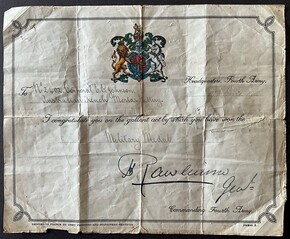JOHNSON, Ernest Edward
| Service Number: | 2402 |
|---|---|
| Enlisted: | Not yet discovered |
| Last Rank: | Private |
| Last Unit: | 17th Infantry Battalion |
| Born: | Not yet discovered |
| Home Town: | Not yet discovered |
| Schooling: | Not yet discovered |
| Occupation: | Not yet discovered |
| Memorials: | East Killara North Sydney Technical High School WW1 Honour Board |
World War 1 Service
| 5 Oct 1915: | Involvement Private, 2402, 17th Infantry Battalion, --- :embarkation_roll: roll_number: '12' embarkation_place: Sydney embarkation_ship: HMAT Themistocles embarkation_ship_number: A32 public_note: '' | |
|---|---|---|
| 5 Oct 1915: | Embarked Private, 2402, 17th Infantry Battalion, HMAT Themistocles, Sydney |
Help us honour Ernest Edward Johnson's service by contributing information, stories, and images so that they can be preserved for future generations.
Add my storyBiography contributed by Aubrey Bairstow
Ernest Edward Johnson was born in Featherstone, New Zealand in 1887. He enlisted in the Australian Imperial Force at Liverpool, New South Wales, in July 1915, stating that he was a carpenter . He stated that he was a 27 year old widower and he gave his young son as his next of kin. His wife Cissie Johnson had died on 4 July 1912 aged 20. He embarked from Australia on 5 October 1915, leaving his son with his mother in North Sydney.
Johnson served with the 17th Australian Infantry Battalion in the French theatre of war from March 1916. He transferred to the 5th Australian Light Trench Mortar Battery the following month. Ernest was wounded in action at Westhoek on 30 September 1917 and again on 9 October 1917, the latter being a severe gunshot wound to the left knee. This saw his admitted to the County of Middlesex War Hospital at St Albans, England for recovery.
His bravery at Westhoek saw a recommendation for the award for the Italian Al Valore Militare. The recommendation states:
This N.C.O. has served with this Battery since its formation and has always proved himself a capable and most worthy N.C.O. He has always taken charge of a mortar in engagements since and has always set a good example to his men. On the occasion of the 30th September 1917 at Westhoek he was sent for ammunition and after encountering severe enemy barrages, losing many of his party killed and wounded, although wounded himself would not leave util he had delivered ammunition to the gun positions in the front line.
Whether the award was ever physically made is unsure. Many fell through the cracks at wars end.
Having advanced to Corporal, and after a period of recuperation Johnson rejoined his unit in France, 21 February 1918. In May he was in action with his unit in support of the 18th Battalion.
The latter was performed in action alongside the 18th Australian Infantry Battalion and for his bravery he was awarded the Military Medal (recommended for a DCM). The citation states:
This N.C.O. whilst in charge of his mortar at Morlancourt near Albert on night of 18th/19th May 1918 served his mortar under heavy machine gun fire and shell fire, in which he had to frequently expose himself to observe the shooting. His fine disregard to personal danger and skilful handling of his mortar enabled him to silence an enemy strong point and contributed to the success of our attack. Under heavy shell fire he subsequently mounted his mortar on S.O.S lines to cover our advanced positions. This N.C.O. has previously done excellent work, notably at Hangard.
Johnson returned to Australia in May 1919 and was discharged 19 July 1919. He died on 4 March 1957 and is buried with his wife in North Sydney.











